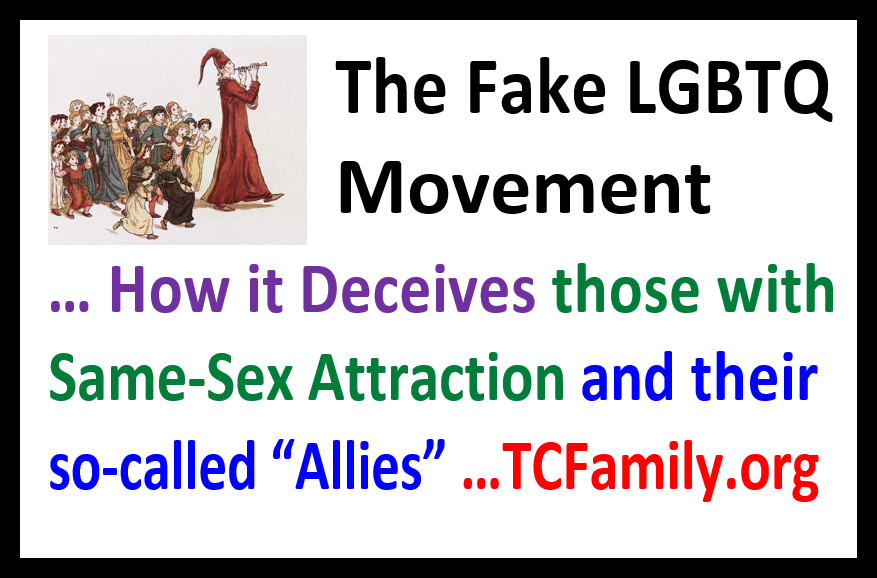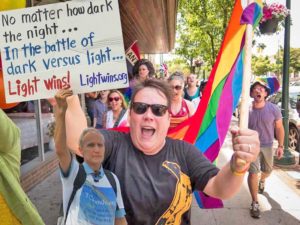Original Link: http://www.narth.com/menus/clinical.html
Homosexuality: The Untold Story
Causes of Same-Sex Attraction
By Susan Brinkmann
(Reprinted with permission of The Catholic Standard & Times. Visit their Web site at www.cst-phl.com .)
May 6, 2004– If genes are not the cause of same-sex attraction in some people, what is?
Dr. Rick Fitzgibbons, a West Conshohocken psychiatrist and principal contributor to the Catholic Medical Association’s book Homosexuality and Hope, identifies the major causes of same-sex attraction disorder (SSAD) in men and women.
Weak Masculine/Feminine Identity
In his contribution to the book by Father John Harvey, The Truth About Homosexuality, Dr. Fitzgibbons writes: “Weak masculine identity is easily identified and, in my clinical experience, is the major cause of SSAD in men. Surprisingly, it can be an outgrowth of weak eye-hand coordination which results in an inability to play sports well. This condition is usually accompanied by severe peer rejection.”
In a culture dominated by sports heroes, it’s easy to understand how a young boy who can’t play ball or run fast may not feel very good about himself. Especially when this is accompanied by ridicule from his peers and perhaps even exclusion and isolation. He may escape the resulting loneliness with academics or by cultivating comfortable relationships with girls.
“The sports wound will negatively affect the image of himself, his relationships with peers, his gender identity, and his body image,” Fitzgibbons writes. “His negative view of his masculinity and his loneliness can lead him to crave the masculinity of his male peers.”
Another major cause for SSAD is when a father is perceived by a child as distant, critical, selfish, angry or alcoholic. This produces yet another crucial conflict in the development of a boy’s masculine identity. “As children and adolescents, these men yearned for acceptance, praise and physical affection from their fathers,” Fitzgibbons said, “but their needs were never met.”
In women, a weak feminine identity leading to SSAD can be caused by mother conflicts, peer rejection or poor body image. Dr. Fitzgibbons writes, “This condition is far more rare than weak masculine identity, and this is why, in my view, male homosexuality is much more common than female homosexuality. The female role model, the mother, is much more likely to be more affirming, to be giving, to be nurturing to her daughter than the father to his son.”
Distrust of Men/Women
Distrust of the opposite sex is the second most common cause of SSAD in men and the most common cause in women. In men, “Feelings of mistrust may develop as a result of a difficult mother relationship or from experiences of betrayal by women,” Fitzgibbons writes. “Male children in fatherless homes often feel overly responsible for their mothers. As they enter their adolescence, they may come to view female love as draining or exhausting. They want a relationship that is lighthearted and enjoyable and, by default, turn to male love.”
In females, the mistrust of men’s love is one of the major conflicts a woman may choose to “resolve” in a homosexual relationship. She may have had a distant, emotionally insensitive or even abusive father and grows up with a fear of being vulnerable to men. Women who have been betrayed in love relationships may also seek safety in a relationship with a woman. Women who are sexually abused or raped as children may find it almost impossible to trust men and turn to a woman instead for affection.
Loneliness is another major factor in the development of SSAD in females. Many women experience disillusionment in their search for the right man and may turn to women instead.
Gender Identity Disorder
“Gender identity disorder in children regularly leads to same-sex attraction in adolescence,” writes Dr. Fitzgibbons. “The Diagnostic and Statistical Manual IV of the American Psychiatric Association defined Gender Identity Disorder (GID) in children as a strong persistent cross-gender identification, a discomfort with one’s own sex, and a preference for cross-sex roles in play or in fantasies.”
Another theory is put forth by Linda Nicolosi of the National Association for Research and Therapy on Homosexuality (NARTH) in her article entitled, Does Born That Way Mean Designed Way?:
“… In some individuals, prenatal hormones may abnormally masculinize or feminize the developing fetus … When a pregnant woman is exposed to certain environmental pollutants which are known to have a hormone-like effect on the body, some writers theorize that differences are blurred in her developing fetus. The resulting gender distortions could affect the child’s sense of himself or herself.”
Narcissism and Profound Selfishness
Dr. Fitzgibbons describes the narcissistic person as a person who is “preoccupied with fantasies of unlimited success, power, brilliance, beauty or ideal love. For the homosexual narcissist, the goal is the pursuit of pleasure. A certain segment of the homosexual community expresses narcissism by promoting total and absolute sexual freedom. They advocate anonymous sex and extreme sexual behaviors that may explain the presence of a high degree of promiscuity in this segment of the population.”
“These are the activists,” Dr. Fitzgibbons said. “They want unlimited promiscuity. They want sex with any one, of any age, at any time. Their goal is to undermine Judeo-Christian morality.”
Dysfunctional Family Life
In the book, Same Sex Attraction: A Parent’s Guide, edited by Father John Harvey and Gerald V. Bradley, Father Harvey agrees with researchers who see faulty family relationships as the source of same-sex attraction.
Referring to the work of Don Schmierer, Father Harvey writes, “He makes use of case histories to illustrate ways in which adolescent boys and girls can have a confused perception of their gender identity…. The fatherless home or the emotionally unavailable father joined with the dominant mother contributes to the development of same-sex attractions …Often where divorce has taken place the mother portrays her ex-husband in very negatives ways, and consequently the son loses respect for the father …. In merged or foster families, one notices relationships among siblings, cousins, or neighbors that are compulsive and secretive and hat can foster same-sex attractions . . .”
Spouses who verbally abuse one another in front of children may inadvertently force the children to “take sides,” and, especially if there is already a distance between a child and a father, a son may begin to see his masculinity in a negative light. Marital infidelity is also a contributing factor, especially if it impacts on an adolescent boy or girl.
Other causes of SSAD are sexual abuse and pedophilia, separation from a parent during the critical time of development, or the failure of parents to encourage same-sex identification and friendships. In a recent interview with ZENIT News, Dr. Fitzgibbons said, “The absence of a father in the home leads to sadness, anger, difficulty in trusting and disruptive disorders. The absence of a mother is worse. One’s mother is one’s fundamental basis of feeling safe in relationships; denying a child of its mother wounds the child’s ability to trust and have faith in the world, which can lead to anxiety and attachment disorders.”
This is why same-sex marriages and adoption can be so devastating on society, because of their affect on children. Fitzgibbons points out that even in Belgium where same-sex unions are approved, same-sex couples are not permitted to adopt.
“Not all adults have the inherent right to have a child,” he said, “but all children have a right to a mother and a father.”
Updated: 3 September 2008


